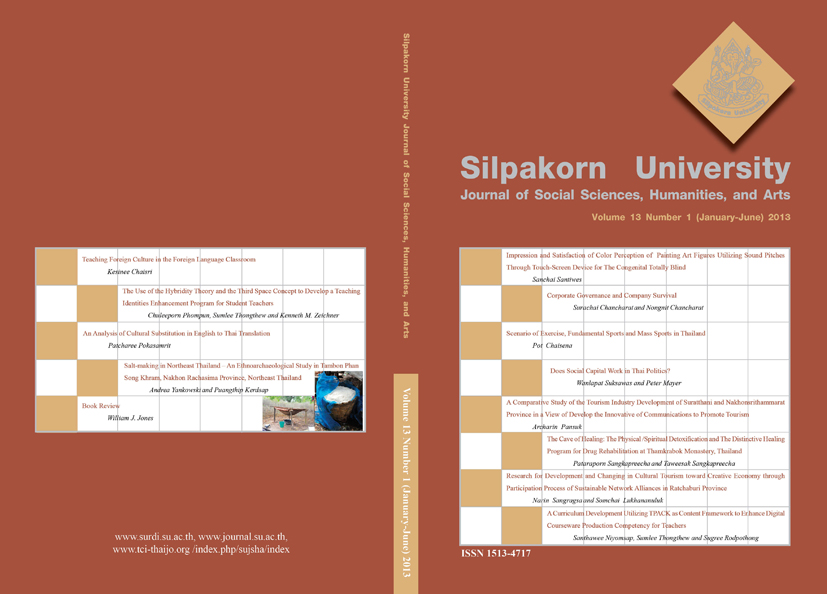Impression and Satisfaction of Color Perception of Painting Art Figures Utilizing Sound Pitches Through Touch-Screen Device for The Congenital Totally Blind
Main Article Content
Abstract
The congenital totally blinds had not the experience or memory about picture and color. They had not opportunity to touch and perceive the figures. Therefore, if they touched, they will perceive textures only and also some materials and colors maybe peel off and damage. This research made the method and device utilize the touch-screen technology and computer software development by converting color values, which are RGB to HLS double cone model, to MIDI sound pitches of musical notes for help the blinds can perceive colors and shapes of painting Art. Software was two separates such as, touching software for colors and shapes perception of painting art and drawing software. When they touched the figures of painting art, they were able to explain, describe and critical it. Art is to communicate for all. This research is the qualitative research that the case studied and applied research types. To studied with the participants who are the congenital totally blinds and educated at the high school level. This research is beginning step. Then, the defined of palette for beginner in the 12 colors, which are the appropriate for basic using. This research is experiment for the participants to touch the painting art utilize touch-screen and remember the sound pitch that appeared in positions of figure. The result of research found that was able to use the sound pitch of musical notes to represent the color, which is used the hearing to represent the vision. They are able to describe and critical it about color, shape and composition. To made the experiences, knowledge and imagination to the blinds, and then they have also the impression and satisfaction of colors and shapes perception of painting art figures between good to very good in this activity. And drawing and painting in color by this device also. The author has offered a useful computer-based process for spatial and color information access for the blind. The screen is 2D and so can give information about a 2D picture just by showing it in simplified form. The colors are represented by pitches, triggered by touching the screen in say a green area of the picture. Blind school age participants in the study enjoyed learning and trying-out the system. Key Words: Color; Colour; Sound; Perception; Draw; Paint; Art; Blind; Computer
Downloads
Article Details
All rights reserved. Apart from citations for the purposes of research, private study, or criticism and review,no part of this publication may be reproduced, stored or transmitted in any other form without prior written permission by the publisher.
References
Bishop, B. (1893) A Souvenir of The Color Organ, with Some Suggestions in Regard to the Soul of The Rainbow and The Harmony of Light. n.p.: The de vine press.
Collopy, F. (2009) Playing (with) Color. Glimpse: The Art + Science of Seeing, 2(3). [Online URL: http://rhythmiclight.com/articles/Playing(With)Color.pdf] accessed on January 14, 2012.
Crosby, N. (2002) FreeVBCode code snippet: MIDI Keyboard Player[computer program]. [Online URL: http://www.freevbcode.com/ShowCode.asp?ID=4213] accessed on April 25, 2010.
Deutsch, D. (1982) The Psychology of Music. London : Academic Press.
Franssen, M. (1991) The Ocular Harpsichord of Louis-bertrand Castel. In Tractrix 3, 1991: 15-77. [Online URL: http://www.gewina.nl/journals/tractrix/franssen91.pdf] accessed on January 14, 2012.
Gebhardt, V. (1997) Painting a Concise History. London : Laurence King Press.
GIMP 2.6.11, (2012) The GNU Image Manipulation Program [computer program]. Massachusetts: The GIMP Development Team. [Online URL: http://www.gimp.org/downloads/] accessed on January 14, 2012.
Gleitman, H. (1992) Basic Psychology (3rd ed.). New York : W.W. Norton.
Jaffé, H. L. C. (1967) 20,000 Years of World Painting. New York : Greenwich House.
Jamuni, P. (2005) Art Criticism : Reaching The Artist’s Thought and Art Form. n.p.
Kennedy, J. M. (1993) Drawing & the Blind: Picture to Touch. New Haven, CT : Yale University Press.Kommong, S. (2009) All About Music. Bangkok : O.S. Printing House. (in Thai)
Lowenfeld, B. (1981) Effects of Blindness on the Cognitive Functioning of Children, in Berthold Lowenfeld on Blindness and Blind People: Selected Papers. New York : American Federation for the Blind.
Microsoft. (1998) Visual Basic 6.0 [computer program]. Washington: Microsoft Corporation.
Microsoft. (2009) Windows 7 [computer program]. Washington : Microsoft Corporation.
Mittler, G. A. (1994) Art in Focus (3rd ed.). New York : Glencoe.
Newton, I. (1721) Opticks: or, a Treatise of The Reflections, Refractions, Inflections and Colours of Light, (3rd ed.). London : Weft End of St. Paul’s.
Nimsamer, C. (1991) Composition of Art. Bangkok : Thaiwattanapanich. (in Thai)
Nopppaket, R. (1997) Psychology of Perception. Bangkok : Prakayprueg. (in Thai)
Peacock, K. (1988) Instruments to Perform Color-Music : 2 Centuries of Technological Experimentation. Leonardo, 21(4): 397-406. [Online URL: http://rhythmiclight.com/articles/InstrumentsToPerformColor.pdf] accessed on January 14, 2012.
Phopruegsanun, N. (2008) Methodology of The Research (5st ed.). Bangkok : Expernet. (in Thai)
Rimington, A. W. (1912) Colour-Music : The Art of Mobile Colour. London : Hutchinson.
Royal Institute of Thailand. (2003) The Royal Institute Dictionary 1999 Edition. Bangkok : Nanmee Book Publications. (in Thai)
Santiwes, S. (2011) Color Perception of Visual Art Painting Utilizing Sound for Totally Blind. Burapha Arts Journal, Special Issue November: 117-136.
Tangcharoen, W. (1992) Color Theory for Creative Art. Bangkok : O.S. Printing House. (in Thai)
Wichawut, S. and others. (2007) General Psychology (5st ed.). Bangkok : Thammasat University Press. (in Thai)


